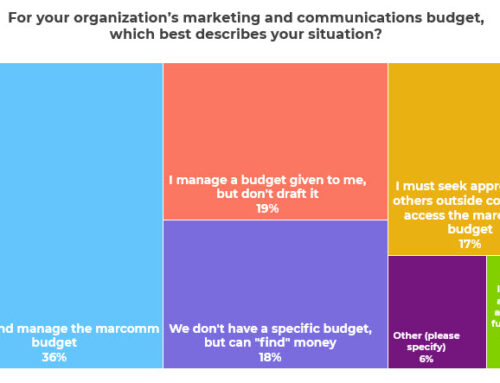 As you may know, I am in the middle of writing the full-length, printed book version of Nonprofit Marketing Guide, to be published in Spring 2010 by Jossey-Bass. As I was writing various chapters on both strategy and tactics, I realized that I was making choices about what to include and what to leave out based on my own set of assumptions about the world that nonprofit communicators are working in. So I decided to make the first chapter of the book a summary of these assumptions.
As you may know, I am in the middle of writing the full-length, printed book version of Nonprofit Marketing Guide, to be published in Spring 2010 by Jossey-Bass. As I was writing various chapters on both strategy and tactics, I realized that I was making choices about what to include and what to leave out based on my own set of assumptions about the world that nonprofit communicators are working in. So I decided to make the first chapter of the book a summary of these assumptions.
Here is the my list of 10 marketing realities for nonprofits, with abridged commentary. Let me know what you think by leaving a comment on the blog, and maybe you’ll end up in Chapter 1!
Reality 1: Marketing is not a dirty word. Neither is communications or public relations.
Marketing gets a bad rap because when it’s done poorly, it can be downright offensive. No one wants to feel like someone, especially a charity, is trying to trick or cheat them. No one likes being yelled at, patronized or coerced. So don’t think of your marketing program as a megaphone or a soap box, but as a conversation. It’s true that some communications tactics are naturally more one-way or impersonal than others, but your marketing program as a whole should include many opportunities for back and forth dialogue with your supporters.
Reality 2: There is no such thing as the general public.
The general public includes everyone, from children to seniors, rich and poor, incarcerated and homeless. No matter how much you try, you will not reach everyone. In fact, if that’s what you try to do, odds are good that you will, in fact, reach no one. Instead, you need to focus on specific groups of people and work toward communicating with them in ways that connect with their particular needs and values.
Reality 3: You need to build your own media empire.
Don’t depend on the mainstream media to get your message out. That sector of our society has its own set of survival problems. Instead, build your own media empire using online tools. I’d much rather see a nonprofit spend a day writing blog posts and uploading photos or videos than writing a press release and calling a scattershot list of reporters about it. Media coverage can still be incredibly helpful. I’m not suggesting that you forgo media relations entirely. But in today’s media environment, I believe you are better off spending more time creating and publishing your own content than trying to talk someone else into publishing it for you.
Reality 4: Old people are online.
Grandma has email and she’s thinking about getting on Facebook too. The Pew Internet & American Life Project’s “Generations Online in 2009” found that the biggest increase in Internet use between 2005 and 2008 was within the 70-75 year-old age group – not just grandparents, but great-grandparents. Older people will continue to get online, and even more significantly, the younger generations, particularly those in their 30s and 40s now who came of age with personal computing, will remain online as they age. Their expectations for communicating online with their favorite charities will likely be extremely high. Prepare to meet those demands by getting through the steepest parts of your learning curve now.
Reality 5: Nonprofit communicators are transforming into community organizers.
Think about when you host in-person events. Isn’t it wonderful to see all of those people who care about your work in one place, talking to each other about the good work you are doing, and feeling good about their contributions to something much bigger than themselves? Smart nonprofits are now using social media tools to create those same cozy feelings online.
Find those people who are enthusiastic about your cause and who also have large networks of their own. Then feed those big fans, and help them spread the message to others. They may fundraise for you, but just as importantly, they’ll also friendraise for you. Organizations that merge now-separate functions of fundraising, communications, and information technology into community building teams will ultimately be more successful in the coming years than those who maintain these professional silos.
Reality 6: Personal and organizational personalities, or brands, are blending.
What is your group known for? This is your organization’s brand, image, or personality — and many nonprofits are finding that their organizational brand is closely related to the personalities of their most public staff members. This has always been true for smaller organizations, groups led by a founding or long-time executive director, and nonprofits created in someone else’s memory or honor. But now larger nonprofits must contend with this reality too. Good online marketing, especially in social media, is personal, which means that your staff should present themselves as real human beings in your communications. The personality of the messenger – you – can affect that organizational message.
Reality 7: Good nonprofit marketing takes more time than money.
Because the Internet has revolutionized communications between organizations and individuals, effective nonprofit marketing programs can be implemented for online pennies on the print dollar. Engaging supporters in conversations is more time-consuming than blasting messages out to them. Managing profiles on multiple social media sites is more time-consuming than updating your website once a month. Writing a blog with several posts per week is more time-consuming than sending out a print newsletter twice a year. While all of these tasks do take more time, they are also more effective at building a community of supporters.
Reality 8: You’ve already lost control of your message. Stop pretending otherwise.
Control over the message about your organization or issue is not yours to give up. It’s already gone. What you can control is your response to how others are communicating about your issues and your organization. If someone wants to bad-mouth you online, they can do it right now whether you are there to see it and respond or not. The truth is that the overwhelming majority of comments that people make about charities online are positive or neutral. For those that are negative, isn’t it better to see them and consciously decide whether or not to respond than to be oblivious to them entirely?
Reality 9: Marketing is not fundraising, but it is essential to it.
Nonprofit marketing has many possible outcomes, and raising dollars is one of them. But nonprofits also use marketing to find and organize volunteers, to persuade decisionmakers, to change public policy, to raise awareness, to encourage behavior changes, and to foment social change.
While you can have successful long-term marketing campaigns that don’t involve fundraising, you cannot have successful long-term fundraising campaigns without marketing. Marketing and communications are how you talk to your donors in between those times when you ask for money. It’s what puts new people into your pool of potential new donors and what keeps current donors happy with your organization so they will give again.
Reality 10: Old-fashioned basics still work best, even online.
“The basics are what most organizations are missing. Obsessing about this is far more effective than managing the latest fad.” I didn’t say that, but I agree with it 100%. Marketing maven Seth Godin said it during a May 2008 online chat about nonprofit marketing hosted by the Chronicle of Philanthropy.
With online marketing in particular, don’t fret about Facebook until your website is in good shape. Don’t get all twisted up about Twitter until your email marketing program is effective. Focus on the basics first, and do them well. Tell good stories. Be grateful, and get your thank-you letters out. Become a valued and trusted source for others. That’s how you make it big.
Agree? Disagree? Want to add another item or two? Leave a comment on the blog.





